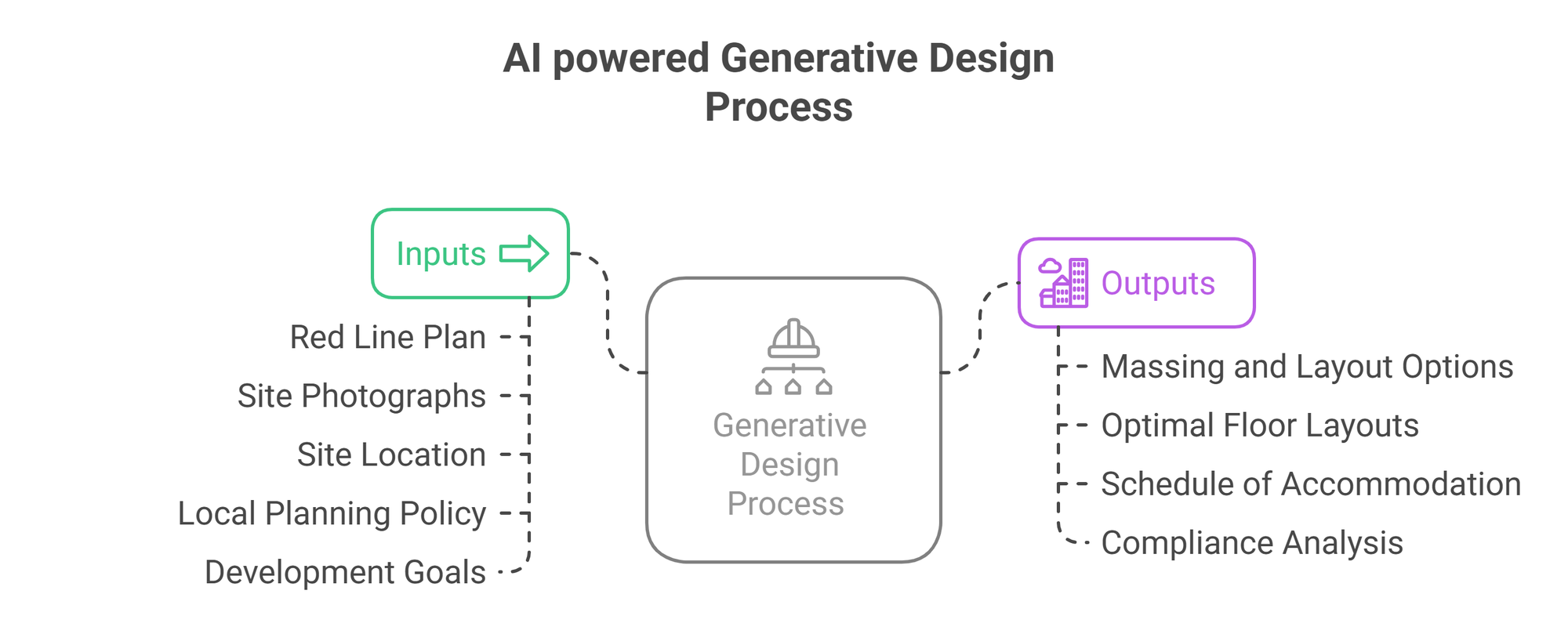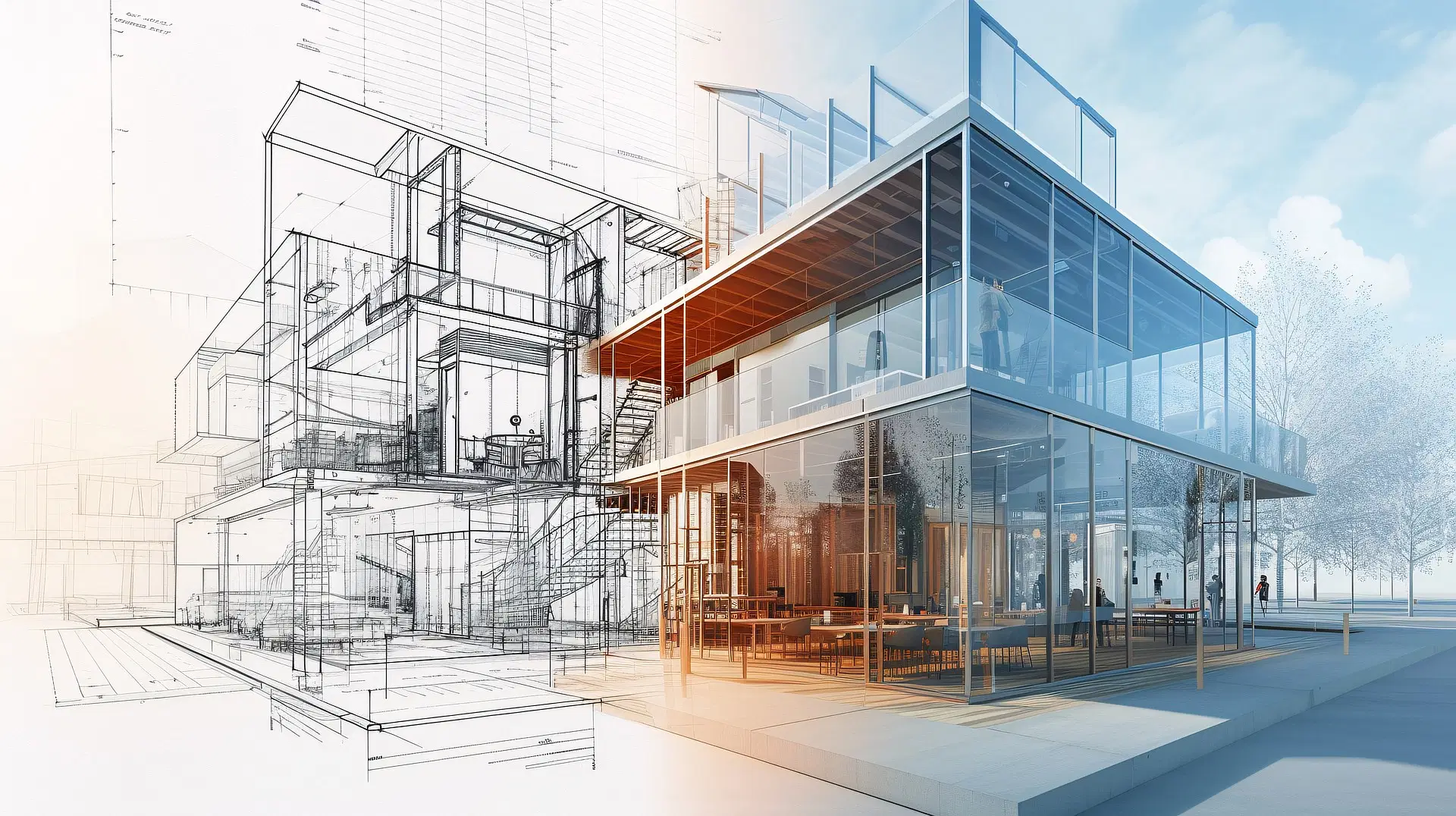Explore how AI-powered generative design tools are transforming early-stage feasibility in UK property. Faster appraisals, smarter decisions, better outcomes.
Every developer and architect knows the drill: you get the redline, sketch a layout, fight the constraints and hope your first draft isn’t a complete write-off...
Sometimes it works. But often, the whole process gets redone three times over once the policy conflicts or budgeting contsraints show up too late.
Now, AI-powered generative design tools are changing that.
These AI-driven platforms let you go from site boundary to multiple, policy-aware design options in minutes instead of weeks.
You don’t just get drawings. You get feasibility that’s aligned with policy, is risk-aware, and tailored to your brief.
This isn’t about replacing creativity. It’s about stopping the guesswork that drains time and budget on both sides of the table.
What Is Generative Design in Property?
At its core, generative design uses AI to create and assess multiple design options automatically based on a set of constraints. Those constraints might be policy-based (height limits, unit mix), physical (levels, trees), or economic (cost per sq ft, carbon targets).
The result? Instead of one or two design options created manually over a week, you get dozens of scenarios in minutes - ranked by how well they meet clients targets.
The technology makes real decisions about:
- Achievable density
- Optimal unit mix
- Whether a massing option respects rights of light, setbacks, or views
- Where there might be leniency in planning policy.
- Which option is most viable based on your goals (profit, sustainability, planning approval)
What These Tools Actually Do
To be clear, these aren’t “push-button and get a masterplan” gimmicks. Here’s what a well-built generative design platform does:
Inputs:
- Site boundary or aerial image
- Site photographs
- Site location
- Local planning policy
- Development goals (target unit numbers, affordability mix, carbon benchmarks)
Outputs:
- Massing and layout options in 2D or 3D
- Optimal floor layouts
- Schedule of Accommodation with optimal unit mix
- Analysis of compliance with planning constraints
- Comparative scenario dashboard highlighting trade-offs (e.g taller building = more units but higher cost & planning risk)
And crucially- it gives you a visual, interactive dashboard. You’re not buried in a PDF. You’re seeing what the tool sees, and adjusting in real time.

Real-World Example: Bryden Wood’s AI Configurators
One of the clearest examples comes from Bryden Wood, a UK-based design and technology firm pioneering digital configurators for residential, industrial, and education schemes.
Here’s how it works:
- A user uploads a redline boundary for a site
- The tool scans for known planning restrictions (height, overlooking distances, parking requirements)
- It instantly generates multiple development options where for example:
- One prioritises maximum density
- Another balances daylight and public realm
- A third aligns most closely with planning precedent
Each comes with a full breakdown of units, floor area, compliance risks, and even basic carbon scoring.
What could take 2 - 3 weeks of architect and planner time now happens in under 30 minutes.
Other platforms pushing similar functionality include:
- Archistar
- Delve (by Sidewalk Labs, Google-backed)
- LandInsight’s Pro tools (in early-stage rollout)
Why It’s Not Just About Speed
Yes, these tools are fast - but that’s not the point.
The real value lies in the level of insight the AI provides. You now get rich, quantified feedback before you’ve committed to a concept.
That means:
- Fewer wasted feasibility studies
- Less design rework post pre-app
- Earlier risk awareness (e.g. BNG obligations, massing conflicts)
- Better-informed acquisition conversations
- A stronger hand when talking to planning consultants or funders
You don’t just save time. You de-risk the entire design journey.
Who should Be Using This Right Now?
Architects:
Use it to explore design options quicker and build trust with clients through clear visual feedback and “design with policy” evidence.
Developers:
Use it to appraise multiple site options faster, and back acquisition bids with data - not just density guesses.
Planning consultants:
Use it to validate whether your design team is creating proposals that align with emerging policy - and flag problem areas early.
Investors & land agents:
Use it to test whether sites actually deliver what sellers promise - and model exit risks at the feasibility stage.
What’s Next: Generative Design as a Development Engine
Right now, AI tools generate feasibility layouts. In the near future, they’ll do much more.
As generative design matures, its role will extend well beyond early-stage feasibility into the detailed design phases of development.
Imagine a near future where AI not only lays out massing strategies but evolves designs seamlessly through RIBA Stages 2–4, from concept to technical design.
At RIBA Stage 3 (Spatial Coordination), generative systems could automatically test thousands of permutations to optimise internal layouts, circulation, and material use. As we move into Stage 4 (Technical Design), AI could automate detailed joinery drawings, schedule doors and windows, and coordinate services layouts with structural and architectural elements.
This doesn’t remove the role of the architect or design team - it redefines it. Professionals would shift from drafting to directing, focusing on creative decisions, stakeholder engagement, and context-specific nuance, while AI manages the heavy lifting of compliance, optimisation, and coordination.
Longer-term, this could mean a radically compressed design timeline, where weeks of design development and consultant coordination are distilled into hours.
In short, generative design won’t just be a tool for early-stage visioning. It could become the engine of development - driving projects through the entire design lifecycle.
Conclusion: Faster Isn’t the Point - Smarter Is
AI-driven generative design doesn’t mean replacing architects or consultants. It means equipping them to work with more clarity, more options, and fewer blind spots.
By generating viable schemes faster, these tools take early-stage feasibility out of the realm of best guesses and into evidence-based decision making.
Subscribe below to stay informed on the latest in AI in UK property, architecture and more.





